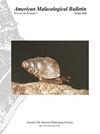无聊双壳类动物:用分子系统发育分析肉毒杆菌的物种特征
IF 0.4
4区 生物学
Q4 MARINE & FRESHWATER BIOLOGY
引用次数: 0
摘要
Wilson和Tait(1984)通过对肉肉属(Botula)中岩石类、贝壳类和珊瑚类双壳类的形态学研究,得出结论:肉肉属(Botula fusca, Gmelin, 1791)是一个单一的近代物种,分布于西大西洋、太平洋和印度洋的泛热带地区。壳的颜色、栖息地、深度和解剖结构的变化反映了这一物种的变化。在随后对近期和化石肉毒杆菌的回顾中,Kleemann(2007)对单型肉毒杆菌表示怀疑,因为几个被描述的物种之间存在“显著的形态差异”,主张研究软组织和应用分子工具来帮助解决物种身份问题。在这里,我们第一次采用分子系统发育方法来探索肉毒杆菌属的物种水平关系。我们的分类群样本包括从佛罗里达群岛国家海洋保护区收集的新标本,这些标本是在珊瑚礁恢复地点正在进行的生物侵蚀双壳类研究的背景下收集的,此外还有以前在佛罗里达自然历史博物馆和圣巴巴拉自然历史博物馆收集的西大西洋、太平洋和印度洋的标本。根据线粒体(COI和16S rRNA)和细胞核(H3和28S rRNA)基因的分析,肉毒杆菌属似乎是单系的,目前有争议的物种被归类为Leiosolenus kleemanni (Valentich-Scott, 2008)属于肉毒杆菌属,而不是Leiosolenus属。本研究中样本之间的序列分化程度很高,包括先前鉴定为“硅肉毒杆菌”、“肉毒杆菌”、“Leiosolenus”kleemanni和fusca肉毒杆菌,支持它们是不同的物种。我们的系统发育分析还在西大西洋肉毒杆菌中发现了一个潜在的隐种。增加对肉毒杆菌属生物多样性的了解,将有助于更准确地了解这些生物侵蚀物种在珊瑚礁生态系统中的作用。本文章由计算机程序翻译,如有差异,请以英文原文为准。
Boring Bivalves: Using Molecular Phylogenetics to Resolve Species Identities in Botula (Mytilidae)
Based on morphological examination of rock-, shell-, and coral-boring bivalves in the marine genus Botula, Wilson and Tait (1984) concluded that this genus comprised a single Recent species, Botula fusca (Gmelin, 1791), with a pan-tropical distribution spanning the western Atlantic, Pacific, and Indian Oceans. Variation in shell colour, habitat, depth, and anatomy were determined to reflect variation within this one species. In a subsequent review of Recent and fossil Botula, Kleemann (2007) expressed doubts about a monotypic Botula given “striking morphological differences” between several described species, advocating for the study of soft tissues and application of molecular tools to help resolve species identities. Here, for the first time, we have undertaken a molecular phylogenetic approach to explore species-level relationships within the genus Botula. Our taxon sampling included freshly collected specimens from the Florida Keys National Marine Sanctuary in the context of ongoing research into bioeroding bivalves at reef restoration sites, in addition to previous collections from the western Atlantic, Pacific, and Indian Oceans available at the Florida Museum of Natural History and the Santa Barbara Museum of Natural History. Based on analyses of mitochondrial (COI and 16S rRNA) and nuclear (H3 and 28S rRNA) genes, the genus Botula appears to be monophyletic, with the contentious species currently classified as Leiosolenus kleemanni (Valentich-Scott, 2008) falling within Botula rather than Leiosolenus. High levels of sequence differentiation among samples in this study, including ones previously identified as “Botula silicula”, Botula cinnamomea, “Leiosolenus” kleemanni, and Botula fusca, supported them as distinct species. Our phylogenetic analyses also identified a potential cryptic species within western Atlantic Botula fusca. Increased knowledge of diversity within the genus Botula should lead to a more accurate understanding of the role of these bioeroding species in reef ecosystems.
求助全文
通过发布文献求助,成功后即可免费获取论文全文。
去求助
来源期刊
CiteScore
1.00
自引率
40.00%
发文量
1
审稿时长
>12 weeks
期刊介绍:
The American Malacological Bulletin serves as an outlet for reporting notable contributions in malacological research. Manuscripts concerning any aspect of original, unpublished research,important short reports, and detailed reviews dealing with molluscs will be considered for publication. Recent issues have included AMS symposia, independent papers, research notes,and book reviews. All published research articles in this journal have undergone rigorous peer review, based on initial editor screening and anonymous reviewing by independent expertreferees. AMS symposium papers have undergone peer review by symposium organizer, symposium participants, and independent referees.

 求助内容:
求助内容: 应助结果提醒方式:
应助结果提醒方式:


